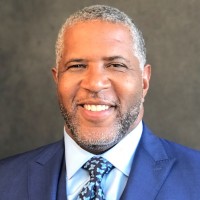- AI in education has existed since Stanford University ran its first computer program in 1965.
- AI in education examples include personalized learning, automated grading and intelligent tutoring systems.
- You will find a variety of pros and cons of AI in education as the technology continues to be refined, including increased efficiency as a pro and potential privacy and ethical concerns as cons.
Artificial intelligence (AI) has taken the world by storm, creating efficiencies and cutting-edge solutions for all industries. Within the educational field, AI is transforming the future of learning and teaching through intelligent tutoring systems, automated grading, adaptive learning platforms and more. These functions not only make the lives of teachers easier but also help address some of the biggest challenges in education today.
In this article, we expand on the role of AI in higher education, provide examples of AI in education and discuss its pros and cons. We also provide ways educators can harness the power of AI in their classrooms.
What Is AI and its History in Education?
AI is a technology that uses computer functions and processes to mimic human intelligence to perform a variety of tasks. There are many types of AI, with generative AI (gen AI) being the most commonly known. Gen AI algorithms can be used to create chatbots, automated replies and more.
The history of AI in education began in 1965 when Stanford University used the first AI program, the PLATO (Programmed Logic for Automated Teaching Operations) computer program. The “PLATO computer program” taught students the basic concepts of mathematics and science.
The PLATO computer program, developed by a team of people at the University of Illinois in the early 1960s, was a significant breakthrough in the history of AI in education. As AI evolved and became more refined, so did its purposes and uses across many industries. Education, in particular, reaped the benefits of AI algorithms and programs as technology advanced.
How Is AI Being Used in Education?
Many different uses of AI in education make the lives of students and teachers easier within the classroom, including personalized learning plans for students and automated grading for teachers. Below, we explore some common examples of AI in education.
Personalized Learning and Adaptive Learning Platforms
No two students are the same, which can require teachers to create tailored learning paths to help struggling students succeed. Personalized learning is a unique educational approach that teachers use to customize each student’s learning experience to meet their individual needs. Adaptive learning platforms have the ability to adapt to each student by understanding their performance and behavior in real time. From there, adjustments can be made to a student’s tasks. This customization allows a student’s strengths, weaknesses, skills and overall needs to be analyzed before creating a learning plan. Through personalized learning, each student can establish their own path to success.
Intelligent Tutoring Systems
Intelligent tutoring systems (ITS) are emerging within the educational field to give students personalized feedback and learning modules. These computer programs are designed to deliver individualized instruction through the power of AI. ITS can transform the future of education for students and will cater to individual needs and learning styles to set students up for success.
Automated Grading
Automated grading systems powered by AI can significantly reduce the amount of time that teachers spend grading. Additionally, they can provide students with their assignment scores and feedback faster. AI’s role in automated grading systems stems from its ability to understand and analyze written responses for key factors, including quality and relevance. It creates a much more efficient process for educators and students alike.
Natural Language Processing for Language Learning
Learning a new language can be a daunting task for many. With AI, natural language processing (NLP) for language learning provides an immersive learning experience for students. NLP combines statistical and machine learning models that enable computers to understand and process language in real-time. Rather than scouring through dry textbooks, NLP platforms for language learning create learning modules that integrate real-world conversations and interactive exercises to make learning a new language easier. In addition, these types of NLP platforms provide instant feedback on pronunciation and translation of a new language.


Get Industry leading insights from Robert F. Smith directly in your LinkedIn feed.
Get Industry leading insights from Robert F. Smith directly in your LinkedIn feed.
What Are the Pros and Cons of AI in Education?
While there are many benefits to using AI in education, including increased accessibility and efficiency, there are still challenges that can arise, including ethical issues with AI. We will dive into the specific pros and cons of AI in education to help you better understand its impact.
Pros
- Accessibility: AI tools can make education more accessible to neurodiverse students by offering alternative formats and adaptive learning features to meet their unique needs.
- Efficiency: AI can automate administrative tasks for educators, freeing up time for personalized interaction with students.
- Data-driven insights: AI analytics can provide valuable data on student performance, learning trends and areas for improvement.
Cons
- Privacy concerns and ethics: AI systems in education can collect and analyze large amounts of student data, leading to concerns about privacy and data security. Aside from the ethics around gathering that type of data, algorithms can create ethical issues and biases based on what the systems are trained on, which could lead to unequal treatment of students.
- Cost: Implementing AI technologies in education can be a large financial investment for schools, potentially widening the digital divide in education.
- Job displacement: Some are concerned that AI automation in education could lead to the displacement of certain roles, including tutors, potentially affecting employment opportunities within the field.
4 Ways Educators Can Harness the Power of AI
Educators have a unique opportunity to harness the transformative power of AI to shape the future of learning for students. In K-12 education and beyond, educators can use a variety of tools and programs to create a better learning environment for their students. Some of the most commonly used AI-powered learning tools include:
- Duolingo: This language learning app helps students learn other languages in real time through repetitions and more.
- Google Classroom: This online learning platform allows teachers to create and manage classes, communicate with students and create assignments.
- Khan Academy: This platform provides educational courses to students through its proprietary “Khanmigo AI.” The program delivers personalized learning to each user.
- Microsoft Teams: This platform allows students and teachers to collaborate on learning modules and projects.
Stay up to date with the latest advancements of AI in education and more by following Robert F. Smith on LinkedIn.






